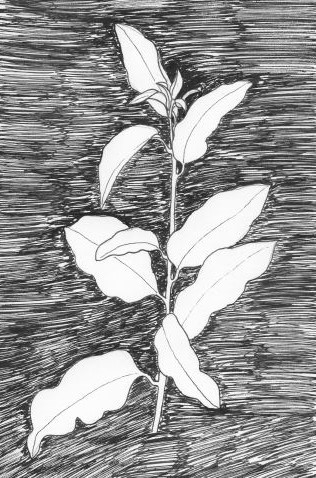Exercise 1.2: Composition with Pen and Ink
In this exercise we are reviewing composition. Composition is very important when creating botanical illustrations. The definition of composition is as follows: The act of combining parts or elements to form a whole, and the resulting state or product. Below are principles of composition:

-
-
-
-
-
-
-
-
-
-
Shape and Proportion
- Positioning, Orientation
- Balance
- Harmony
- Negative Space
- Color
- Contrast
- Geometry
- Rhythm
- Lighting
- Repetition
- Perspective
-
-
-
-
-
-
-
-
-
To begin, get out your sketch pad, a single pencil and pen set. You also have the option of using your quill and ink. If you are not confident in using quill/ink, for this exercise you can use your pen set. People seem to have strong preferences and opinions about ink -- we encourage you to use what works best for you.
The first part of this exercise is to find a plant specimen. The ideal subject is a single stem with foliage or petals (either a single flower with leaves, or a tree twig with (or without) simple foliage will work well). Place your plant study on a blank white paper for better focus on the shapes and composition.
On your paper, start listing the physical features of your plant. List the basic shapes, lines, and textures. You can also list other descriptions such as shiny, wild, invasive, or stiff. Be creative with your list! Looking over your list, visualize how your sketch will be composed. Think of those terms to complete your composition.
Using your pencil, draw the outline of the specimen with straight single lines (not scratchy) Remember while drawing to keep the principles of composition in mind. After completing your first sketch, rearrange your plant specimen for a new composition and sketch again. You can practice this several times to find new and interesting compositions.
After a few sketches have been created, pick out the one you feel is best. Use your pen or ink to outline and enhance the sketch. Then, color in the negative space with your pen or ink. This will help you study negative space and show more clearly your overall layout. After completion, sign/date your work and scan for submission. Please read pages 20-24 in your book that addresses this exercise.